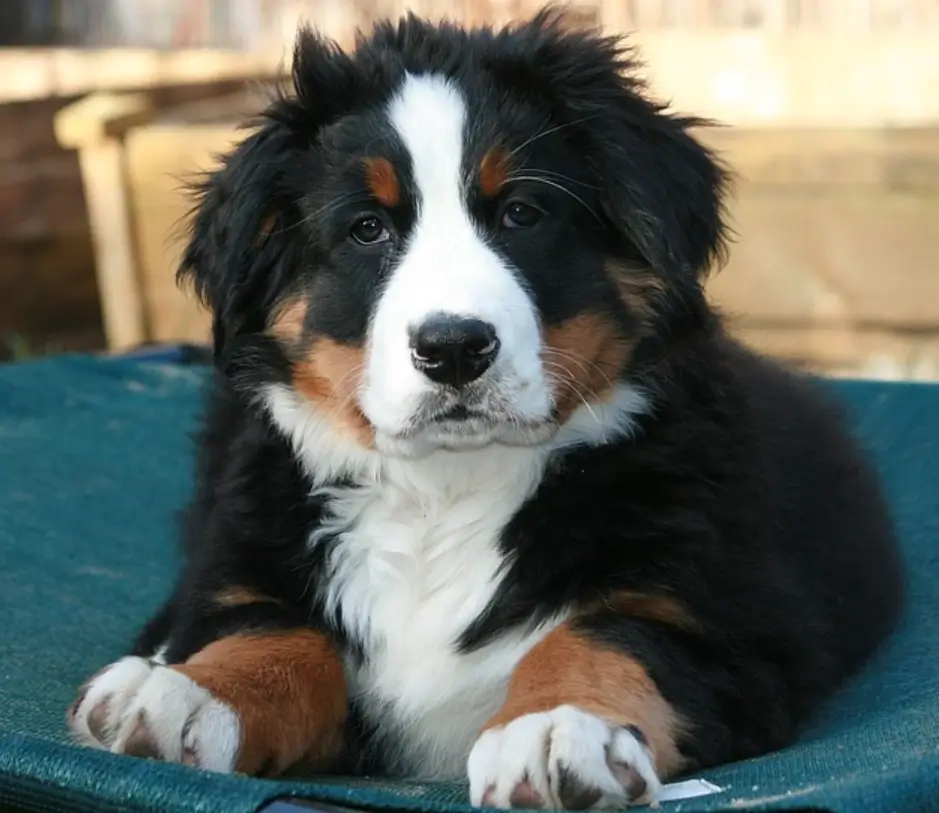The Unfurnished Bernedoodle is a popular and captivating variation within the beloved Bernedoodle breed, renowned for its unique coat characteristics and charming personality. This comprehensive guide will explore the characteristics, genetics, appearance, care requirements, and recognition status of the Unfurnished Bernedoodle.
What is an Unfurnished Bernedoodle?
The Unfurnished Bernedoodle is a specific variation within the Bernedoodle breed. Distinguished by a straight or wavy coat with minimal facial furnishings, this dog inherits its traits from the Bernese Mountain Dog and the Poodle, creating a delightful blend of striking features.
- Coat Characteristics: The primary distinction lies in the coat, where unfurnished Bernedoodles have less pronounced facial hair, giving them a distinct appearance.
- Temperament: Unfurnished Bernedoodles are renowned for their friendly and sociable nature, making them excellent family pets.
- Hypoallergenic Qualities: While not entirely hypoallergenic, unfurnished Bernedoodles, like their curly-coated counterparts, tend to shed less and may be more suitable for individuals with allergies.
Genetics
The genetics behind unfurnished Bernedoodles involve the “F” locus, which controls whether a dog will have a smooth coat or a longer, fluffier coat. A dog must have at least one copy of the “F” locus to have a fluffy coat.
Unfurnished Bernedoodles typically have two copies of the “F” locus, resulting in a smooth coat. In contrast, a dog with no “F” locus will have a smooth coat, but will shed more. The primary contributors to their genetic makeup are the Bernese Mountain Dog and the Poodle.
- Bernese Mountain Dog Influence: Known for their striking tri-color coats, Bernese Mountain Dogs contribute the distinct color patterns seen in unfurnished Bernedoodles.
- Poodle Influence: Poodles are recognized for their curly and hypoallergenic coats. When bred with Bernese Mountain Dogs, they impart a variety of coat types, including the straight or wavy coat seen in unfurnished Bernedoodles.
- Genetic Variation: The outcome in each litter can vary, resulting in a mix of furnished and unfurnished Bernedoodle puppies, even from the same parents.

What is the Difference Between Furnished and Unfurnished Bernedoodles?
The key difference between a furnished and unfurnished Bernedoodle lies in the presence of “coat furnishings,” particularly facial hair or “bearding.” Unfurnished Bernedoodles lack facial hair and have a smoother face, often resembling their Bernese relatives with a straighter coat.
This unique coat type is associated with lower grooming maintenance and reduced shedding, making it an appealing option for those seeking a Bernedoodle with a more traditional look and easier care.
Unfurnished Bernedoodles shed far less than their Bernese counterparts, typically being medium to low-shedding dogs. They can still have a curly coat, but their lack of facial hair makes them distinctive. The unfurnished Bernedoodle offers a low-maintenance, stylish alternative to their furnished counterparts, making them an attractive option if you’re looking for a Bernedoodle with a more traditional look and easier care.
Care Procedures
Here are the care practices to observe when dealing with this particular breed:
- Grooming: Regular brushing is essential to maintain the coat’s health and prevent matting. Even though they shed less than some other breeds, routine grooming is still necessary.
- Exercise: Unfurnished Bernedoodles are an energetic breed. Daily walks, playtime, and mental stimulation are crucial to keep them happy and healthy.
- Training: These intelligent dogs respond well to positive reinforcement training. Start training early to establish good behavior and obedience.
- Socialization: You should expose your dog to various environments, people, and other pets from a young age to ensure they develop into well-adjusted and sociable adults.
The Best Grooming Practices
- Regular Brushing:
- Brush your Unfurnished Bernedoodle’s coat regularly to prevent tangles and matting. Depending on the length of the coat, brushing every few days is generally sufficient.
- Use the Right Tools:
- Use a slicker brush or a comb suitable for your dog’s coat type. A detangling spray can also be helpful, especially if your furry friend has a wavy coat.
- Focus on Trouble Areas:
- Pay special attention to areas prone to matting, such as behind the ears, around the neck, and in the leg feathers. Thoroughly comb through these areas to prevent knots from forming.
- Bathing:
- Bathe your pup as needed, typically every 4-6 weeks or when they get dirty. Use a dog-friendly shampoo and conditioner to keep the coat clean and healthy.
- Ear Cleaning:
- Regularly check and clean your dog’s ears to prevent wax buildup and potential infections. Use a vet-recommended ear-cleaning solution and a gentle touch.
- Nail Trimming:
- Trim your dog’s nails regularly to maintain their paw health. Be cautious not to cut too close to the quick, and use a pair of dog nail clippers or a grinder.
- Teeth Care:
- Brush your dog’s teeth several times a week to promote good oral health. Use a dog-friendly toothbrush and toothpaste recommended by your veterinarian.
- Professional Grooming:
- Consider scheduling professional grooming sessions, especially if your pup has a longer coat. Professional groomers can help trim, shape, and maintain an overall well-groomed appearance.
- Check for Skin Issues:
- Regularly inspect your dog’s skin for any signs of irritation, redness, or lumps. If you notice anything unusual, consult with your veterinarian.
- Positive Reinforcement:
- Make grooming a positive experience for your pup by using treats and praise. This will help them associate grooming with positive feelings and reduce anxiety.
Is an Unfurnished Bernedoodle a Recognized Breed?
This particular breed is not recognized by major kennel clubs. However, individual breeders and enthusiasts may recognize and appreciate this unique coat variation within the broader Bernedoodle community. 
How Much Does an Unfurnished Bernedoodle Puppy Cost?
The cost of acquiring an Unfurnished Bernedoodle puppy can vary based on several factors, including:
- Breeder Reputation: Reputable breeders who prioritize responsible breeding practices, health screenings, and proper care may charge higher prices.
- Genetic Line: The puppy’s pedigree, bloodline, and the presence of desirable traits can influence the cost.
- Demand: High demand for Unfurnished Bernedoodles may contribute to higher prices, so it’s essential to consider the availability and waitlists with reputable breeders.
You should be prepared for an investment ranging from $2,000 to $4,000 or more.
Conclusion
The Unfurnished Bernedoodle adds a captivating twist to the popular Bernedoodle breed. Their unique coat variation, charming appearance, and amiable temperament make them an excellent choice for families and individuals. You should understand the genetics, appearance, care requirements, and recognition status of this particular breed before welcoming it to your home.
FAQs
Are Unfurnished Bernedoodles hypoallergenic?
Unfurnished Bernedoodles tend to shed less than some other breeds, making them more suitable for individuals with allergies.
Can I find Unfurnished Bernedoodle puppies easily?
Unfurnished Bernedoodle puppies may be available through reputable breeders. However, due to the uniqueness of their coat variation, you need to be patient and potentially join waitlists.
How often should I groom my Unfurnished Bernedoodle?
Regular grooming is essential to prevent matting and maintain coat health. Aim to brush at least a few times weekly and schedule professional grooming as needed.
Are Unfurnished Bernedoodles good with children?
Yes, Unfurnished Bernedoodles are generally known for their friendly and sociable nature, making them excellent family pets. Early socialization is key to ensuring positive interactions with children.
RELATED: What is an Australian Mountain Doodle?
